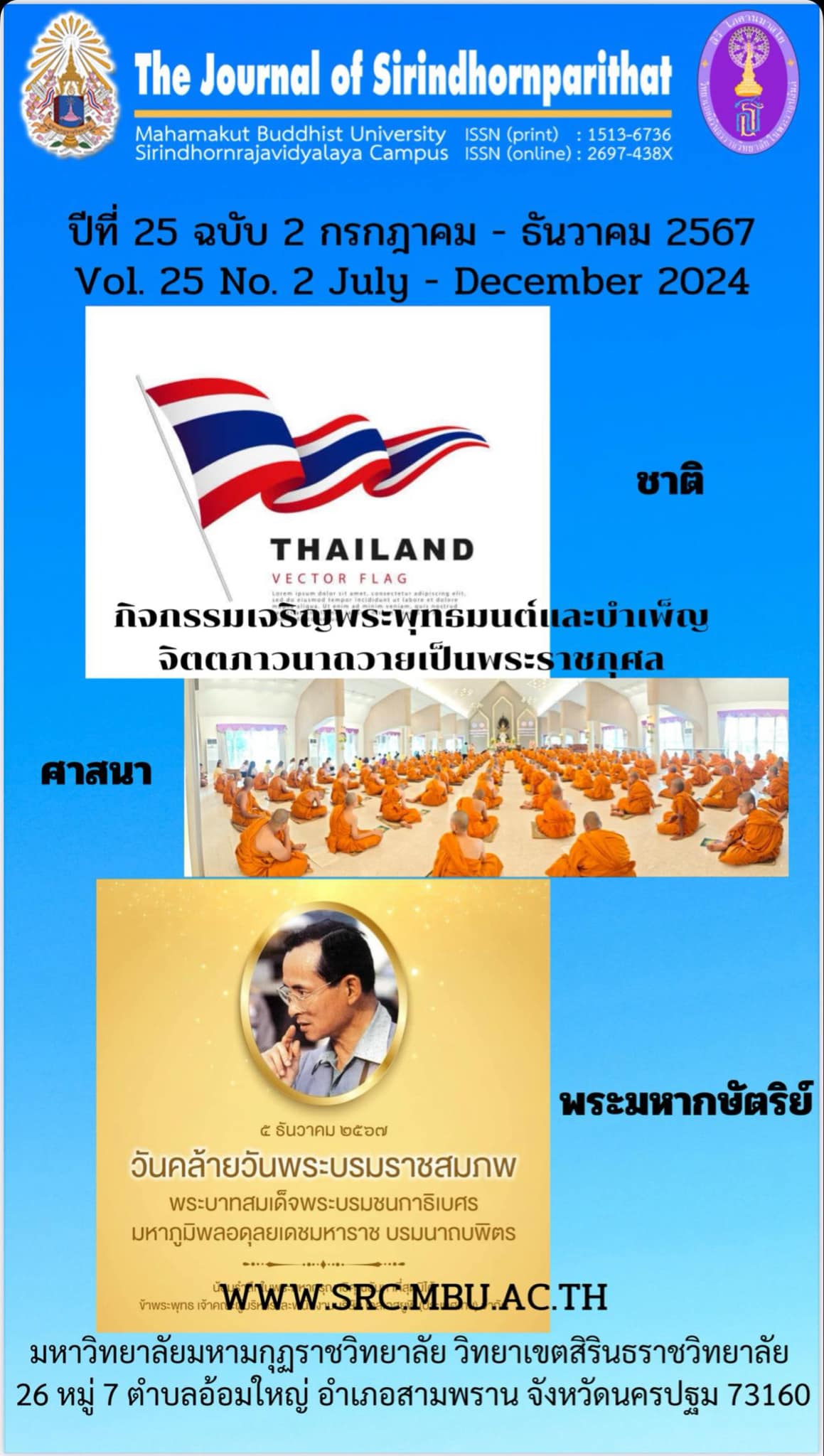Guidelines for Teamwork Development of Teachers in Schools of Nakhon Nayok Primary Educational Service Area Office
Keywords:
Guidelines, Teamwork DevelopmentAbstract
The purpose of this research was 1) to study the priority needs index for teamwork development of teachers in schools. 2)to propose guidelines for teamwork development of teachers in schools. There are two steps in the research methodology: 1) to study the priority needs index for teamwork development of teachers in schools. The sample consisted of 302 teachers performing teaching duties in schools under the Nakhon Nayok Primary Educational Service Area Office. The simple random sampling method was applied by drawing lots A questionnaire was used as the research instruments. The reliability of the current condition is 0.98, and the desired condition is 0.98. The percentage, mean, standard deviation, and priority needs index were employed in data analysis. 2to propose guidelines for teamwork development of teachers in schools. Purposive sampling method was used to obtain 5 main informants. The research tool was a semi-structured interview applying content analysis.
The results of the research were as follows: 1) The overall of priority needs index of guidelines for teamwork development had a priority needs index (PNI) was equaled to 0.04. Considering each aspects found that the first highest priority needs index (PNI) was trust giving, had a priority needs index (PNI) was equaled to 0.06. And the second was setting team objectives and clear goals, had a priority needs index (PNI) was equaled to 0.05. And the lowest was revealed communication and acceptance to each other, had a priority needs index (PNI) was equaled to 0.03 respectively. 2) The guidelines for teamwork development consisted of 7 aspects 31 approaches as follows: 1) setting team objectives and clear goals; there are 7 approaches for example, To setting team objective and goals of main tasks and subtasks. 2) revealed communication; there are 5 approaches for example, There are good relationship for communication inside by teamwork. 3) working participation; there are 5 approaches for example, To do the activities and plan the activities systematically to promote the cooperation of members continuously. 4) acceptance to each other; there are 4 approaches for example, All member accept and respect together. 5) human relations; there are 4 approaches for example, To promote all member express appropriately their leadership and followers 6) trust giving; there are 3 approaches for example, Members can exchange their opinion and often knowledge sharing to perception together. 7) roles defining and clear assignment; there are 3 approaches for example, To do an duties assignment and clearly responsibility on writing.
References
กระทรวงศึกษาธิการ. (2553). พระราชบัญญัติการศึกษาแห่งชาติ พ.ศ. 2542 แก้ไขเพิ่มเติม (ฉบับที่ 2) พ.ศ. 2545 และ (ฉบับที่ 3) พ.ศ. 2553. กรุงเทพฯ: ผู้แต่ง.
ธานินทร์ ศิลป์จารุ. (2561). การวิจัยและวิเคราะห์ข้อมูลทางสถิติด้วย SPSS. (พิมพ์ครั้งที่ 16). กรุงเทพฯ: บิสซิเนสอาร์แอนด์ดี.
ประหยัด ชำนาญ. (2562). การพัฒนาแนวทางการทำงานเป็นทีมสำหรับสถานศึกษาสังกัดองค์การบริหารส่วนจังหวัดชัยภูมิ. (วิทยานิพนธ์การศึกษามหาบัณฑิต), สาขาวิชาการบริหารการศึกษา, มหาวิทยาลัยมหาสารคาม.
พสชนันท์ บุญช่วย. (2561). อิทธิพลของความสุขในการทำงาน ความไว้วางใจในองค์กร และความมั่นคงในงาน ส่งผลต่อความผูกพันและประสิทธิภาพในการทำงานของพนักงานบริษัทผลิตอุตสาหกรรม จังหวัดปทุมธานี, Veridian E-Journal, บัณฑิตวิทยาลัย มหาวิทยาลัยศิลปากร.
พัสวีพิชญ์ ศิลาสุวรรณ. (2565). การทำงานเป็นทีมของผู้บริหารสถานศึกษาสังกัดสำนักงานเขตพื้นที่การศึกษาประถมศึกษาชลบุรี. (วิทยานิพนธ์ศึกษาศาสตรมหาบัณฑิต), มหาวิทยาลัยเทคโนโลยีราชมงคลธัญบุรี.
รุ้งเพชร ทรัพย์เจริญ. (2563). การทำงานเป็นทีมของข้าราชการครูในสถานศึกษาอำเภอบางน้ำเปรี้ยว สังกัดสำนักงานเขตพื้นที่การศึกษาประถมศึกษาฉะเชิงเทรา เขต 1. (วิทยานิพนธ์ศึกษาศาสตรมหาบัณฑิต), สาขาการบริหารการศึกษา, มหาวิทยาลัยบูรพา.
ลำเทียน เผ้าอาจ. (2559). การทำงานเป็นทีมของข้าราชการครูในโรงเรียนขยายโอกาสอำเภอเมืองตราด สังกัดสำนักงานเขตพื้นที่การศึกษาประถมศึกษาตราด. (วิทยานิพนธ์การศึกษามหาบัณฑิต), สาขาวิชาการบริหารการศึกษา, มหาวิทยาลัยบูรพา.
Ayres, C. L. (1993). The relationship between productivity and work team autonomy and effectiveness. Dissertation Abstracts International, 54(2), 379-A.
Hall, W. R. (1999). The use of dual planning periods by middle school team. Dissertation Abstracts International, 59(9), 547 -556.
Krejcie, R. V., & Morgan, D., W. (1970). Determining sample size for research activities. Education and Psychological Measurement, 30(3), pp.608-609.
Parker, G. M. (1990). Team players and teamwork: The new competitive business strategy. California: Jessey & Bass.
Pitoe, J. V. (2014). How do school management tems experience teams experience teamwork: A case study in the school in school in the Kamweng district, Uganda Mediterrnean. Journal of social science, 5(3), 21 -27.
Woodcock, M., & Francis, D. (1994). Team building strategy. Hampshire: Gower Publishing.
Downloads
Published
Issue
Section
License
Copyright (c) 2024 Mahamakut Buddhist University

This work is licensed under a Creative Commons Attribution-NonCommercial-NoDerivatives 4.0 International License.
บทความที่ได้รับการตีพิมพ์เป็นลิขสิทธิ์ของ มหาวิทยาลัยมหามกุฏราชวิทยาลัย วิทยาเขตสิรินธรราชวิทยาลัย
ข้อความที่ปรากฏในบทความแต่ละเรื่องในวารสารวิชาการเล่มนี้เป็นความคิดเห็นส่วนตัวของผู้เขียนแต่ละท่านไม่เกี่ยวข้องกับหาวิทยาลัยมหามกุฏราชวิทยาลัย วิทยาเขตสิรินธรราชวิทยาลัย และคณาจารย์ท่านอื่นๆในมหาวิทยาลัยฯ แต่อย่างใด ความรับผิดชอบองค์ประกอบทั้งหมดของบทความแต่ละเรื่องเป็นของผู้เขียนแต่ละท่าน หากมีความผิดพลาดใดๆ ผู้เขียนแต่ละท่านจะรับผิดชอบบทความของตนเองแต่ผู้เดียว



